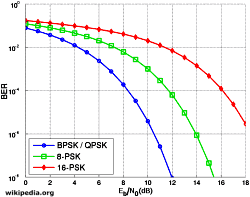|
 Bit
error rate (BER) is used in digital telecommunication as a figure of merit for how
effectively the receiver is able to decode transmitted data. It is the percentage
of bits that have errors relative to the total number of bits received in a transmission,
usually expressed as ten to a negative power. For example, a transmission might
have a BER of 10-5, meaning that on average, 1 out of every of 100,000
bits transmitted exhibits an error. The BER is an indication of how often a packet
or other data unit has to be retransmitted because of an error. If the BER is higher
than typically expected for the system, it may indicate that a slower data rate
would actually improve overall transmission time for a given amount of transmitted
data since the BER might be reduced, lowering the number of packets that had to
be resent. Bit
error rate (BER) is used in digital telecommunication as a figure of merit for how
effectively the receiver is able to decode transmitted data. It is the percentage
of bits that have errors relative to the total number of bits received in a transmission,
usually expressed as ten to a negative power. For example, a transmission might
have a BER of 10-5, meaning that on average, 1 out of every of 100,000
bits transmitted exhibits an error. The BER is an indication of how often a packet
or other data unit has to be retransmitted because of an error. If the BER is higher
than typically expected for the system, it may indicate that a slower data rate
would actually improve overall transmission time for a given amount of transmitted
data since the BER might be reduced, lowering the number of packets that had to
be resent.
[borders/_temp/2-28-2024/google-300x250-ad-unit-included-file-right.htm]A
common example of this is with a dial-up modem connection to an ISP (for those remaining
who do not have broadband, or at least can remember the bad old days). During the
initialization sequence when communications are being established between the computer
modem and the ISP modem, it was possible to hear the digital noise. An arbitration
process ensued whereby the highest data rate is attempted and if it resulted in
too high of a BER, the modems mutually agreed to drop back to a lower rate. The
process continued until an acceptable BER was achieved. That is why sometimes you
would get a 50,2 kB connection, while at other times you might get only a 24.6 kB
connection. In my own experience, the lower data rates were almost a certainty when
it was raining; evidently poor insulation somewhere in the telephone lines allowed
enough current leakage between conductors, or degraded poor connections enough to
cause significantly higher noise.
A BERT (bit error rate test or tester) is a procedure or device that measures
the BER for a given transmission.

when added noise level approaches noise floor of receiver:

where:
fb = transmission bit rate
N = total noise power in band (dBm)
N0 = noise spectral density (dBm/Hz)
ni = injected noise spectral density (mW/Hz)
Eb = energy per bit (dBm/Hz)
C = carrier power (dBm)
T = ambient temperature (K)
k = Boltzmann's constant = 1.380 x 10-23 (J/K)
F = noise factor at injection point of receiver
|











